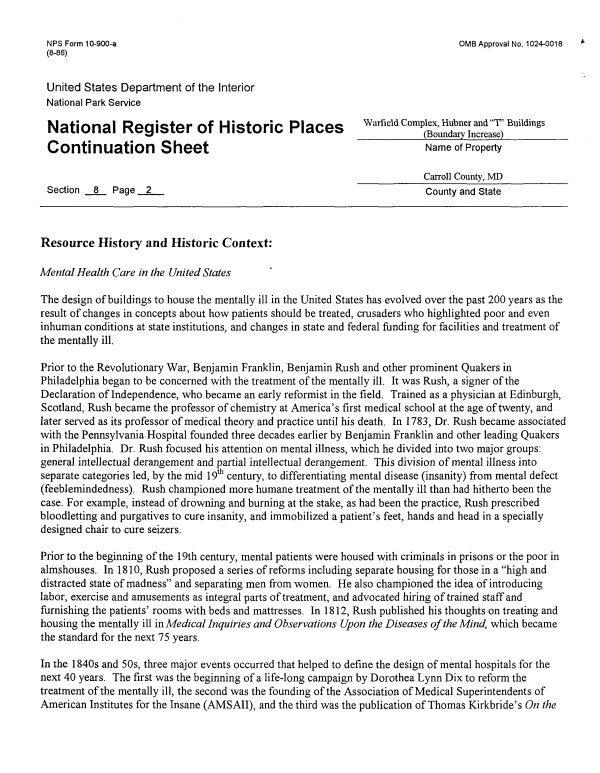 |
||||
|
DEPARTMENT OF HOUSING AND COMMUNITY DEVELOPMENT, MARYLAND HISTORICAL TRUST (Historic Sites Survey) var.d. MSA SE16-7 Image No: se16-7-0315 Enlarge and print image (72K) |
 |
||||
|
DEPARTMENT OF HOUSING AND COMMUNITY DEVELOPMENT, MARYLAND HISTORICAL TRUST (Historic Sites Survey) var.d. MSA SE16-7 Image No: se16-7-0315 Enlarge and print image (72K) |
| NFS Form 10-900-a OMB Approval No. 1024-0018 (8-86) United States Department of the Interior National Park Service Warfield Comp" Buildings National Register of Historic Places __________ Continuation Sheet Name of Property Carroll County, MD Section 8 Page _2__ County and State Resource History and Historic Context: Mental Health Care in the United States The design of buildings to house the mentally ill in the United States has evolved over the past 200 years as the result of changes in concepts about how patients should be treated, crusaders who highlighted poor and even inhuman conditions at state institutions, and changes in state and federal funding for facilities and treatment of the mentally ill. Prior to the Revolutionary War, Benjamin Franklin, Benjamin Rush and other prominent Quakers in Philadelphia began to be concerned with the treatment of the mentally ill. It was Rush, a signer of the Declaration of Independence, who became an early reformist in the field. Trained as a physician at Edinburgh, Scotland, Rush became the professor of chemistry at America's first medical school at the age of twenty, and later served as its professor of medical theory and practice until his death. In 1783, Dr. Rush became associated with the Pennsylvania Hospital founded three decades earlier by Benjamin Franklin and other leading Quakers in Philadelphia. Dr. Rush focused his attention on mental illness, which he divided into two major groups: general intellectual derangement and partial intellectual derangement. This division of mental illness into separate categories led, by the mid 19th century, to differentiating mental disease (insanity) from mental defect (feeblemindedness). Rush championed more humane treatment of the mentally ill than had hitherto been the case. For example, instead of drowning and burning at the stake, as had been the practice, Rush prescribed bloodletting and purgatives to cure insanity, and immobilized a patient's feet, hands and head in a specially designed chair to cure seizers. Prior to the beginning of the 19th century, mental patients were housed with criminals in prisons or the poor in almshouses. In 1810, Rush proposed a series of reforms including separate housing for those in a "high and distracted state of madness" and separating men from women. He also championed the idea of introducing labor, exercise and amusements as integral parts of treatment, and advocated hiring of trained staff and furnishing the patients' rooms with beds and mattresses. In 1812, Rush published his thoughts on treating and housing the mentally ill in Medical Inquiries and Observations Upon the Diseases of the Mind, which became the standard for the next 75 years. In the 1840s and 50s, three major events occurred that helped to define the design of mental hospitals for the next 40 years. The first was the beginning of a life-long campaign by Dorothea Lynn Dix to reform the treatment of the mentally ill, the second was the founding of the Association of Medical Superintendents of American Institutes for the Insane (AMSAII), and the third was the publication of Thomas Kirkbride's On the |